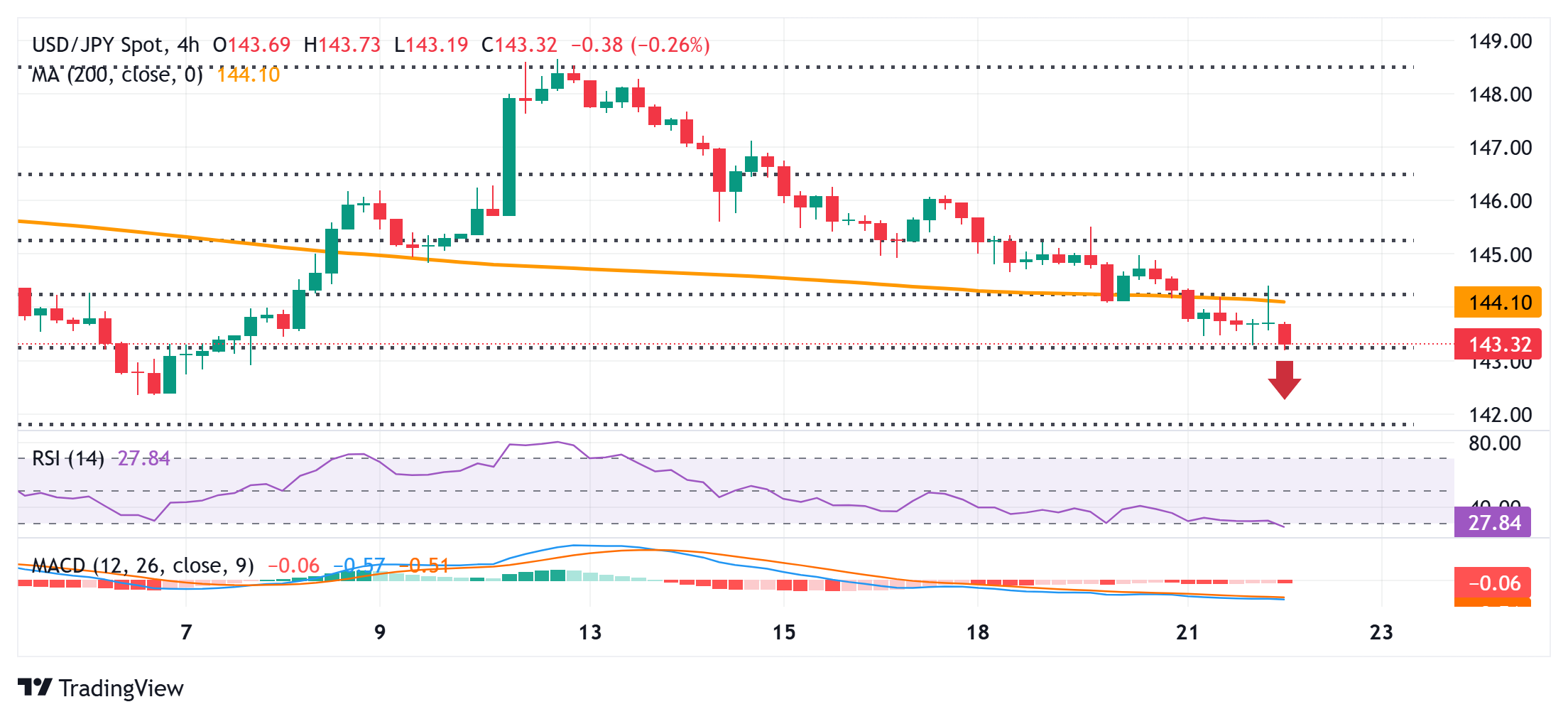Japanese Yen advances to fresh two-week highs against a weaker USD

- The Japanese Yen attracted some dip-buyers following upbeat domestic data.
- BoJ rate hike bets and reviving safe-haven demand also lend support to the JPY.
- The prevalent USD selling bias exerts additional downward pressure on USD/JPY.
The Japanese Yen (JPY) regained positive traction following an early Asian session slide in reaction to Japan’s upbeat Machinery Orders data, which countered recession fears and boosted hopes for an economic recovery. This comes on top of expectations that the Bank of Japan (BoJ) will hike interest rates again in 2025 and provide a goodish lift to the JPY. Apart from this, the flight to safety is seen as another factor underpinning the JPY.
US President Donald Trump’s proposed sweeping tax bill fueled concerns about the US government’s fiscal health. This, along with renewed US-China tensions, takes its toll on the global risk sentiment and forces investors to take refuge in traditional safe-haven assets, including the JPY. This, along with the prevalent US Dollar (USD) selling bias, drags the USD/JPY pair to a two-week low, closer to the 143.00 round figure on Thursday.
Japanese Yen draws support from Japan’s upbeat Core Machinery Orders data; hawkish BoJ expectations
- Data released earlier this Thursday showed that Japan’s Core Machinery Orders – a key leading indicator of capital spending over the next six to nine months – rose 13.0% in March, defying forecasts for a 1.6% decline. This marks the highest level in nearly two decades and assists the Japanese Yen to attract dip-buyers.
- The Bank of Japan recently showed a willingness to hike interest rates further this year amid signs of broadening inflation in Japan. Moreover, investors expect that rising wages could lead to a significant increase in consumption, which, in turn, should allow the central bank to continue on its path of policy normalisation.
- US President Donald Trump’s dubbed “One Big, Beautiful Bill” is expected to come to the House floor for a vote sometime on Thursday, and if passed, will add $3 trillion to $5 trillion to the federal deficit over the next ten years. This adds to worries about a deteriorating US fiscal outlook and weighs on investors’ sentiment.
- China accused the US of abusing export control measures and violating Geneva trade agreements after the US issued guidance warning companies not to use Huawei’s Ascend AI chips. China’s Commerce Ministry said on Wednesday that US measures on advanced chips are ‘typical of unilateral bullying and protectionism.’
- Federal Reserve officials expressed concerns over economic and business sentiment in the wake of the uncertainty tied to the Trump administration’s trade policies. Adding to this, a weak 20-year Treasury bond sale reinforced the view that investors are shying away from US assets and kept the US Dollar depressed.
- Trump reportedly told European leaders that Russian President Vladimir Putin isn’t ready to end the war with Ukraine, as he thinks he is winning. Meanwhile, Israel’s military continued to pound the Gaza Strip and block desperately needed food aid. This keeps geopolitical risks in play and further benefits the safe-haven JPY.
- Thursday’s release of flash PMIs could provide a fresh insight into the global economic health. Moreover, trade developments should influence the broader risk sentiment. Adding to this, the US macro data – the usual Weekly Initial Jobless Claims and Existing Home Sales – might provide some impetus to the USD/JPY pair.
USD/JPY could accelerate the downward trend once the 61.8% Fibo. retracement level support is broken
From a technical perspective, the USD/JPY pair’s intraday move up on Thursday falters near the 144.40 region. The said area nears a confluence support breakpoint – comprising the 50% retracement level of the April-May rally and the 200-period Simple Moving Average (SMA) on the 4-hour chart – and should act as a key pivotal point. A sustained strength beyond could trigger a short-covering move, though it is likely to attract fresh sellers near the 145.00 psychological mark. This should cap spot prices near the 145.35-145.40 region, or the 38.2% Fibo. retracement level, which, if cleared decisively, might shift the near-term bias in favor of bullish traders.
Meanwhile, oscillators on the daily chart have just started gaining negative traction and suggest that the path of least resistance for the USD/JPY pair remains to the downside. However, the Relative Strength Index (RSI) on the 4-hour chart has moved on the verge of breaking into oversold territory, making it prudent to wait for some near-term consolidation before positioning for the next leg of a downfall. That said, acceptance below the 143.20 area, or the 61.8% Fibo. retracement level, might prompt some technical selling and drag spot prices below the 143.00 round figure, to the next relevant support near the 142.40-142.35 area en route to the 142.00 mark.
Economic Indicator
Machinery Orders (MoM)
New orders, released by the Cabinet Office, are the total value of machinery orders placed at major manufacturers in Japan. They are legally binding contracts between consumers and producers for delivering goods and services. The report is considered the best leading indicator of business capital spending, and increases are indicative of stronger business confidence and therefore, as larger the number is, the positive it tends to be for the currency, while a negative reading is understood as a drop down in growth.
Last release:
Wed May 21, 2025 23:50
Frequency:
Monthly
Actual:
13%
Consensus:
-1.6%
Previous:
4.3%
Source:
Japanese Cabinet Office
